Inflation
Inflation is a common occurrence in the world’s economies which occurs when the prices of goods and services go up for a given period of time. When this happens, the economy’s currency is normally negatively affected because its value decreases such that the currency during inflation buys lesser goods and services. For example, an inflation rate of 3% will make the cost of an item initially costing $1 to cost $1.03 during the inflation period. Inflation is normally controlled using an economy’s macro-economic framework, which is usually the mandate of the Central Bank of any country.
Opportunity cost
An opportunity cost occurs when an individual or firm foregoes an alternative good/service or investment of its resources respectively. The opportunity cost will therefore be the cost of the good/service that has been forgone. In case of a firm, if it chooses to invest its resource in a given investment, then the opportunity cost of the firm’s decision is the value that the next highest-valued alternative investment has
GDP (Gross Domestic Product)
It is one of the measures used to determine the economic well being of a nation. GDP is therefore the summation of the monetary value of services and goods that are provided in a certain nation per annum. It encompasses all the purchases of a nation as well as government spending in all the sectors of the economy. GDP is normally interplay between the earnings and spending of a nation. For example exports of a nation will increase the value of GDP while imports will on the other hand decrease its value.
Deficit
The term deficit in economics is used to refer to a situation of greater expenditure than an individual’s or investment’s income. In order to get the value of a deficit, the difference between cash outflows and inflows is computed. For example, a government’s budget is in deficit when the value of the nation’s expenditure exceeds the national income/revenue. When the vice versa occurs, it is referred to as surplus since spending is less than income generated.
Consumer Price Index
This is the statistical measure of price level changes of goods or services bought by a consumer. However, this is done by taking a number of commodities bought by the consumer whereby the change in price of each commodity is ascertained, added and the average obtained. The figure arrived at is the weighted average price which is in turn the consumer price index. Normally, economic analysts utilize the dynamics of consumer price index in gauging the cost of living.
Debt
In economic terms being in debt means having the obligation to pay or deliver goods or services in accordance to a given agreement. The term is commonly used to refer to government’s debt which is the money that a government is owed by the central bank as well as other money lending institutions. The government’s debt is also known as public debt because it indirectly affects the general public. When a government of a nation is in debt, the citizens are affected since the burden of interest to be paid on the debt is bestowed upon the taxpayers.
Micro-economics
Microeconomics is a sub-branch of economics that deals with the study of the small units of the economy especially the markets. As such, it looks at the behavior of markets and the market key players such as firms among others. It therefore entails the study of demand and supply, consumer behaviors of individuals, utility theory, as well as profit maximization in markets.
Macro-economics
Unlike microeconomics, macroeconomics looks at the economy in a broader perspective by studying the government and nation at large. It therefore looks at the behaviors of various markets and companies and how they affect the economy of a nation. As such, it is concerned with matters of inflation, globalization, unemployment, fiscal and monetary policies, and economic growth just to mention a few.
Fiscal
Fiscal is a term used in economics to refer to anything that is of revenue or government nature. In other words, fiscal is what defines the finances of a government. Thus, we can have a fiscal year which is simply the period covered by the annual financial statements. In addition, fiscal policy is using the expenditure of the government to influence its economic progress.
Production Possibility Curve
This refers to a model that is used by economic analysts to show how certain resources can be utilized in producing two different products. In that case, the factors of production are constant and in order to determine the production level of each product, a production possibility curve is used. It can therefore be used to make a decision on the goods to be produced as well as their combination. Below is an example of a production possibility curve.
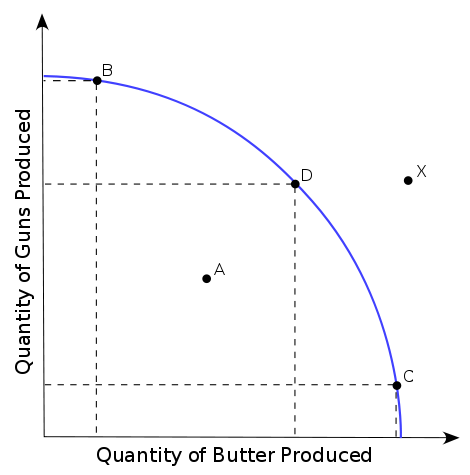
Essay Questions
Supply and Demand
Supply is a concept of economics that indicates quantity that producers in a given market can offer for the buyers in the same market to buy. Demand on the other hand refers to the quantity of a good or service that buyers of a given market are willing to buy at the market price.
Demand and supply model
In a market, the demand and supply model is used to determine the price of the good or service by getting the equilibrium point of interception of the demand and supply curves. At equilibrium point, quantity supplied of a service or product is normally equal to the quantity of the service or product demanded.
Qd=Qs
This is illustrated in the graph below.
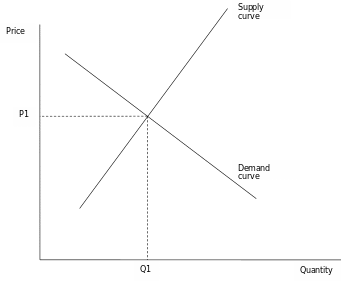
The dominant variables are quantity demanded denoted by Q1 and market price denoted by P1.
Shortage and Surplus
A shortage in a market scenario occurs when the demand of a commodity/ service exceeds the supply by sellers. In that case, some of the buyers demanding a product/service will not be able to get it in the market given the low quantity supplied. Surplus is the opposite of shortage whereby, the sellers have more supply than the demand of the buyers. This can be demonstrated in the diagram below.
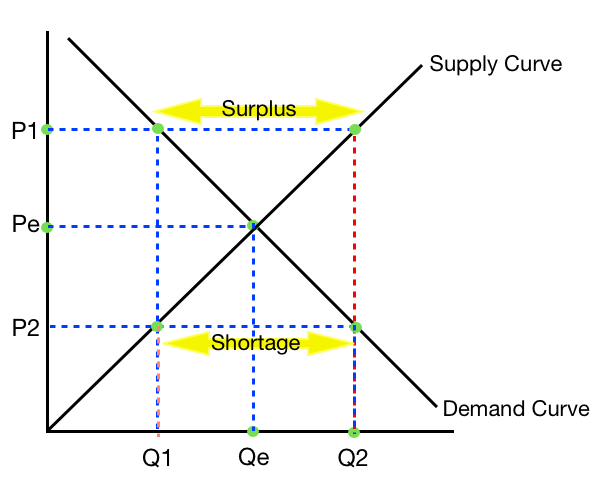
Dynamic changes in a market
The demand and supply curves of a market are subject to shifts and movements depending on the situation. When this happens, a new equilibrium point is normally formed thus having a new demand, supply and price.
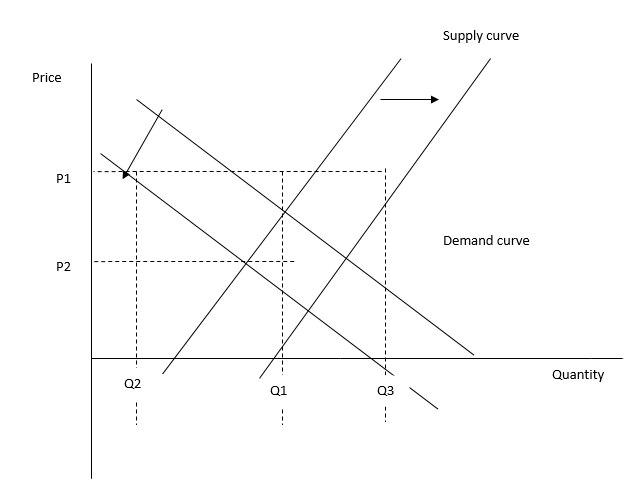
For example, in the diagram above, the equilibrium point moves from (p1, q1) to (ps, q2) given the shifts in demand and supply curves.
Demand and supply versus aggregate demand and aggregate supply
The microeconomic demand and supply model shows the relationship of the two curves in a market scenario while the aggregate demand and aggregate supply show the relationship on a wide scope such as a nation. For instance aggregate supply is the overall quantity of a product/service supplied nationwide while aggregate demand is the overall quantity of goods or services that the citizens and foreigners of a given nation are willing to buy at given price levels.
Question 2
Business cycle
This is a curve that shows fluctuation in the economy of a nation in terms of the trade activity and aggregate production over a given period. As such a business cycle shows the periods of recessions and expansion in a nation’s economy. This can be demonstrated in the diagram below.
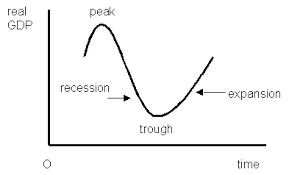
When an economy is in the expansion period of the cycle, it is considered to be doing well economically. This is because indicators such as individual’s income, employment, sales and production are increasing while inflation is decreasing. During recession, the vice versa of the aforementioned indicators occurs.
Importance of GDP
The GDP is an essential economic tool used to determine how well or bad the economy of a given nation is doing. The fact that it shows the total production of a nation, it helps in gauging whether the exports and local usage of a nation’s production is adding value to the economy of a nation. All these help determine the size of economy hence the ability to group big and small economies.
Real and Nominal GDP
Nominal GDP differs from its real counterpart mainly because real GDP is adjusted for indicators such as inflation and changes in price levels while nominal GDP is not. This in turn means that the value of nominal GDP is greater than that of real GDP given the adjustment.
GDP price deflator
This refers to a measurement system used to convert measured products in the current price to the fixed-GDP dollar rate. The metric indicates the value of GDP that is dependent on price level changes.
Measuring economic growth
Economic growth is the increase in the productivity of a nation within a given period of time, mostly one year. Economic growth can be determined using various methods that include use of GDP, which shows the monetary quantity of services and products produced by a certain economy within given period. When real GDP is used as a measure of economic growth, it has to be adjusted for rates of inflation unlike in nominal GDP. It can thus be concluded that real GDP is a better measure of economic growth when compared to nominal GDP.
Importance of macro-economic growth measurement
Macro-economic growth measurement is of great significance to a nation because it helps in establishing the potential of an economy thus being able to predict times of economic expansion and recession. In that case, a nation is able to take measures to prevent events of recession and on the other hand take advantage of expansion periods. In addition to this, macro-economic growth measurement helps in making comparisons with other nations in similar economic zones.
